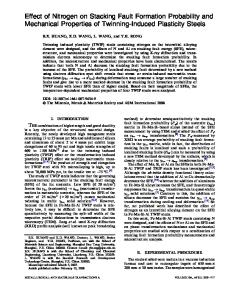Effect of welding speed on microstructure and mechanical properties of laser-welded transformation induced plasticity (T
- PDF / 3,204,723 Bytes
- 12 Pages / 595.276 x 790.866 pts Page_size
- 82 Downloads / 339 Views
ORIGINAL PAPER
Effect of welding speed on microstructure and mechanical properties of laser‑welded transformation induced plasticity (TRIP) steels Tao Wang1 · Mei Zhang2,3 · Ren‑dong Liu4 · Liang Zhang1 · Lin Lu1 · Wen‑heng Wu1 Received: 22 July 2019 / Revised: 27 December 2019 / Accepted: 7 January 2020 © China Iron and Steel Research Institute Group 2020
Abstract The weldability of 0.28C–2.0Mn–0.93Al–0.97Si (wt.%) transformation induced plasticity (TRIP) steels was investigated using a 2.5 kW CO2 laser at the welding speeds of 2, 2.5 and 3 m/min. The welded joints were characterized in terms of hardness, tensile properties and microstructure. High-quality welded joints of TRIP steels with the carbon equivalent of 0.7 were obtained. Lower loss of ductility, nearly unvaried hardness of the fusion zone (FZ) and tensile strength equal to the base metal were observed with increasing welding speed. Lath martensite and lower bainite formed in FZ and the microstructure of FZ varied little with welding speed. Weld thermal simulations of heat-affected zone (HAZ) were carried out using a quenching dilatometer, and the microstructures of dilatometric samples revealed the carbon diffusion-controlled transformations in HAZ. The microstructure distribution of HAZ could be influenced by the welding speed due to the significant temperature gradient over the narrow HAZ. Keywords Laser welding · Welding speed · Transformation induced plasticity steel · Tensile property · Weld thermal simulation · Microstructural evolution
1 Introduction Transformation induced plasticity (TRIP) steels have attracted much attention in the past twenty years due to their good combination of strength and ductility. Many studies have been carried out to investigate the laser welding characteristics of TRIP steels since weldability is a key consideration for their application in automotive industry. It was found that the mechanical properties and microstructure of welded joints can be significantly affected by welding conditions and alloying elements. Han et al. [1] investigated the welded TRIP800 steels using a C O2 laser and found that the * Tao Wang [email protected] 1
Shanghai Research Institute of Materials, Shanghai Engineering Research Center of 3D Printing Materials, Shanghai 200437, China
2
School of Materials Science and Engineering, Shanghai University, Shanghai 200072, China
3
State Key Laboratory of Advanced Special Steels, Shanghai University, Shanghai 200072, China
4
Technique Center of Ansteel, Ansteel Group Corporation, Anshan 114001, Liaoning, China
formability of welded joints could be improved by using a mixed shielding gas. Xia et al. [2] studied the effect of alloying elements on metallurgical transformation by the comparison between diode laser-welded Al-alloyed and Si-alloyed TRIP steels, and proposed that the addition of Al element could affect the phase constituent and ductility of fusion zone (FZ). Zhao et al. [3] made a comparison of the microstructural characteristics between laser-welded and gas tungst
Data Loading...











